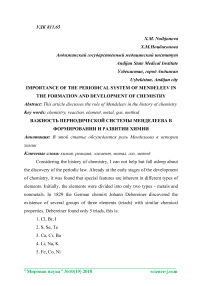Importance of the periodical system of Mendeleev in the formation and development of chemistry
Автор: Noibjonova X.M.
Журнал: Мировая наука @science-j
Рубрика: Основной раздел
Статья в выпуске: 10 (19), 2018 года.
Бесплатный доступ
This article discusses the role of Mendeleev in the history of chemistry
Chemistry, reaction, element, metal, gas, method
Короткий адрес: https://sciup.org/140263098
IDR: 140263098
Текст научной статьи Importance of the periodical system of Mendeleev in the formation and development of chemistry
Considering the history of chemistry, I can not help but fall asleep about the discovery of the periodic law. Already at the early stages of the development of chemistry, it was found that special features are inherent in different types of elements. Initially, the elements were divided into only two types - metals and nonmetals. In 1829 the German chemist Johann Debereiner discovered the existence of several groups of three elements (triads) with similar chemical properties. Debereiner found only 5 triads, this is:
-
1. Cl, Br, I
-
2. S, Se, Te
-
3. Ca, Cr, Ba
-
4. Li, Na, K
-
5. Fe, Co, Ni
This discovery of the properties of the elements led to further research by chemists who tried to find rational ways of classifying the elements.
In 1865 the English chemist John Newlands (1839-1898) became interested in the problem of periodic recurrence of the properties of elements. He arranged from known elements in order of increasing their atomic masses as follows: H Li Be B C N O F Na Mg Al Si P S Cl K Ca Cr Ti Mn Fe
Newlands noted that in this sequence the eighth element (fluorine) resembles the first (hydrogen), the ninth element resembles the second, etc. Thus, after every eight elements, the properties were repeated. However, in this system of elements there was a lot of wrong:
-
1) There were no new elements in the table.
-
2) The table did not disclose the possibility of a scientific approach to the determination of atomic masses and did not allow choosing between their probable best values.
-
3) Some elements were presented as not-successfully placed in the table. For example, iron was compared with sulfur (!), Etc.
Despite a large number of shortcomings, Newlands' attempt was a step in the right direction. We know that the discovery of the periodic law belongs to Dmitri Ivanovich Mendeleev. Let's consider the history of his discovery. In 1869, NA Menshutkin presented to the members of the Russian Chemical Society a small work by DI Mendeleyev, «The Relation of Properties with the Atomic Vessel of Elements.» (DI Mendeleev himself was not present at the meeting.) At this meeting, the work of DI Mendeleyev was not taken seriously. Paul Walden wrote later: «Large events too often met with a slight response, and that day, which was to be a significant day for a young Russian chemical society, but in reality it turned out to be a day-to-day day.» DI Mendeleev loved insolent ideas. The regularity discovered by him read: the chemical and physical properties of the elements of their compounds are in periodic dependence on the atomic weights of the elements. Like its predecessors, Mendeleyev singled out the most typical elements. However, he suggested the presence of voids in the table and dared to argue that they should be filled with not yet open elements. At the same time, Lentar Meyer, who published his work in 1870, worked with Mendeleyev on this same problem. However, prioritizing the opening of the periodical, it deservedly remains for Dmitri Ivanovich Mendeleyev, tk. even L. Meier himself did not think to deny the outstanding role of DI Mendeleyev in the discovery of the periodic law. In his memoirs, L. Meyer pointed out that he used the abstract of the article by DI Mendeleyev when writing his work. In 1870, Mendeleev introduced some changes into the table: how any pattern based on the bepm idea, the new system proved to be viable, because it provided for the possibility of refinement. As I said, the genius of Mendeleyev's theory was that he left emptiness in his table. Thus, he suggested (or rather was sure) that not all elements are open. However, Dmitry Ivanovich did not stop there. With the help of the periodic law, he even described the chemical and physical properties of yet not discovered chemical elements, for example: gallium, germanium, scandium, which were fully confirmed. After that, most scientists were convinced of the correctness of the theory of DI Mendeleyev. In our time, the periodic law has a huge value. With the help of his predict the properties of chemical compounds, products of reactions. With the help of the periodic law and in our time, they predict the properties of elements - these are elements that can not be obtained in significant quantities.
After the works of Lavoisier, Proust, Lomonosov and Mendeleev, many important discoveries in the field of chemistry and physics were already made in our century. This work on thermodynamics, the structure of the atom and molecules, electrochemistry - this list can continue indefinitely. However, the discoveries of Lavoisier and DI Mendeleyev remain the basis of chemical knowledge.
Список литературы Importance of the periodical system of Mendeleev in the formation and development of chemistry
- Растительные ресурсы. Наука, Ленинград, 2005, с.26.
- М. Тоmita, T/ Kugo //, L.Pharm. Soc.Japan. 75.753 (2005) C.A. 2005.49.13597.
- М. Тоmita, Т. Kugo.// L.Pharm.Soc.Japan. 77.1075 (1957) С.А.2001. 52. 5429.
- ЮсуфбековХ.Ю., ХусановаХ.М., СадыковЮ.Д., Акназаров О.А., ПорядинаТ.В. докл. АН Тадж. ССР.2005,26,712.


